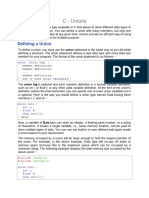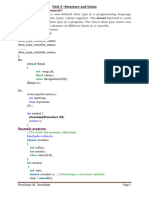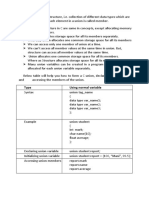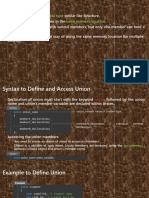0% found this document useful (0 votes)
18 views3 pagesUnion
In C, a union is a user-defined data type that allows storing different data types in the same memory location, with only one member being able to hold a value at a time. The document explains the syntax for declaring unions, creating union variables, accessing members, and initializing unions, along with examples demonstrating their usage. Additionally, it highlights that the size of a union is determined by the size of its largest member.
Uploaded by
kingspapsfeb2025Copyright
© © All Rights Reserved
We take content rights seriously. If you suspect this is your content, claim it here.
Available Formats
Download as DOCX, PDF, TXT or read online on Scribd
0% found this document useful (0 votes)
18 views3 pagesUnion
In C, a union is a user-defined data type that allows storing different data types in the same memory location, with only one member being able to hold a value at a time. The document explains the syntax for declaring unions, creating union variables, accessing members, and initializing unions, along with examples demonstrating their usage. Additionally, it highlights that the size of a union is determined by the size of its largest member.
Uploaded by
kingspapsfeb2025Copyright
© © All Rights Reserved
We take content rights seriously. If you suspect this is your content, claim it here.
Available Formats
Download as DOCX, PDF, TXT or read online on Scribd
/ 3






































































